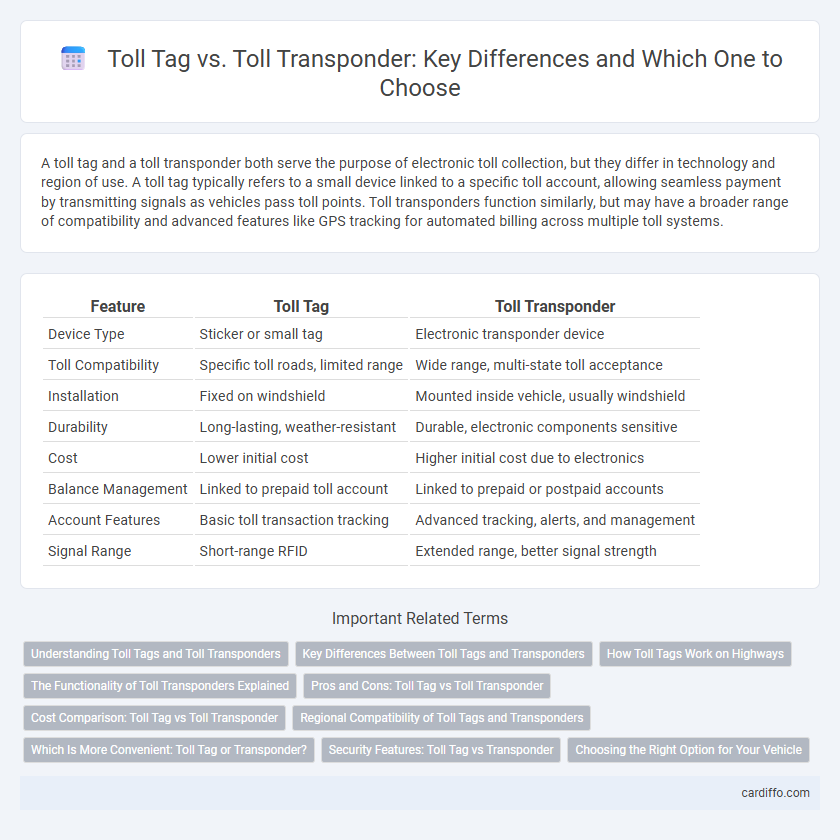A toll tag and a toll transponder both serve the purpose of electronic toll collection, but they differ in technology and region of use. A toll tag typically refers to a small device linked to a specific toll account, allowing seamless payment by transmitting signals as vehicles pass toll points. Toll transponders function similarly, but may have a broader range of compatibility and advanced features like GPS tracking for automated billing across multiple toll systems.
Table of Comparison
| Feature | Toll Tag | Toll Transponder |
|---|---|---|
| Device Type | Sticker or small tag | Electronic transponder device |
| Toll Compatibility | Specific toll roads, limited range | Wide range, multi-state toll acceptance |
| Installation | Fixed on windshield | Mounted inside vehicle, usually windshield |
| Durability | Long-lasting, weather-resistant | Durable, electronic components sensitive |
| Cost | Lower initial cost | Higher initial cost due to electronics |
| Balance Management | Linked to prepaid toll account | Linked to prepaid or postpaid accounts |
| Account Features | Basic toll transaction tracking | Advanced tracking, alerts, and management |
| Signal Range | Short-range RFID | Extended range, better signal strength |
Understanding Toll Tags and Toll Transponders
Toll tags and toll transponders are electronic devices designed to enable automatic toll payments on highways and bridges. Toll tags are typically company-branded devices linked to a prepaid or billed account, while toll transponders may refer broadly to any electronic device, including third-party solutions, used to communicate with toll collection systems. Understanding the differences ensures travelers select compatible devices, avoid fines, and optimize their toll payment experience.
Key Differences Between Toll Tags and Transponders
Toll tags and toll transponders both enable electronic toll collection, but toll tags typically refer to small, sticker-like devices linked to a prepaid account, while toll transponders are bulkier, battery-powered units that can store more data and support multiple toll systems. Toll tags are often passive RFID devices activated by toll plaza readers, whereas transponders actively transmit signals and offer additional features like GPS tracking or account management. Understanding these differences helps drivers choose between convenience and functionality when paying road tolls.
How Toll Tags Work on Highways
Toll tags operate using RFID technology that communicates with electronic readers installed at highway toll points, allowing vehicles to pass through without stopping. When a vehicle equipped with a toll tag approaches a toll plaza, the reader detects the tag and automatically deducts the toll fee from the associated account. This system streamlines traffic flow, reduces congestion, and ensures precise toll collection on highways.
The Functionality of Toll Transponders Explained
Toll transponders are electronic devices that communicate directly with toll collection systems to enable automatic payment without stopping. Unlike general toll tags, transponders use radio frequency identification (RFID) technology to transmit account information instantly at toll plazas, ensuring seamless travel. This functionality reduces traffic congestion and improves toll payment accuracy by eliminating manual transactions.
Pros and Cons: Toll Tag vs Toll Transponder
Toll tags offer easy electronic toll payments with seamless use across multiple toll roads, reducing wait times but may lack compatibility with all toll systems. Toll transponders provide broader interoperability, including variable frequency setups for diverse tolling infrastructures, yet they can be bulkier and more expensive than simple toll tags. Choosing between a toll tag and transponder depends on the required coverage area, vehicle type, and user preference for convenience versus system compatibility.
Cost Comparison: Toll Tag vs Toll Transponder
Toll tags generally offer a lower upfront cost compared to toll transponders, making them a budget-friendly option for frequent drivers. While toll transponders may involve higher initial fees, they often provide enhanced features such as wider network compatibility and faster processing times. Long-term cost savings vary based on usage frequency and the specific toll systems supported by each device.
Regional Compatibility of Toll Tags and Transponders
Toll tags and toll transponders vary in regional compatibility, with most devices designed to work within specific states or regional toll networks such as E-ZPass in the Northeast or SunPass in Florida. Some advanced toll transponders support interoperability across multiple regions, enabling seamless travel through different tolling systems without requiring separate devices. Confirming regional compatibility before purchasing a toll tag or transponder ensures optimal functionality and prevents additional fees due to incompatible toll infrastructure.
Which Is More Convenient: Toll Tag or Transponder?
Toll tags and toll transponders both facilitate automatic toll payments, but toll tags are often more convenient due to their compact design and compatibility with multiple toll agencies. Transponders typically offer broader functionality, such as inter-state usage and faster transaction processing, but may require more installation effort. Choosing between a toll tag or transponder depends on travel frequency, geographic range, and the specific toll systems used.
Security Features: Toll Tag vs Transponder
Toll tags and toll transponders both facilitate automated toll payments, but toll transponders offer enhanced security features such as encrypted data transmission and tamper-resistant hardware to prevent unauthorized access and cloning. Toll tags typically use simpler RFID technology with basic authentication protocols, making them more vulnerable to skimming and fraud. Advanced toll transponders incorporate real-time authentication measures and secure key management systems to safeguard users' financial information and ensure accurate toll collection.
Choosing the Right Option for Your Vehicle
Selecting the right toll device depends on your vehicle type and travel frequency; toll tags are typically linked to a specific vehicle and offer convenience for frequent users. Toll transponders provide flexibility by allowing use across multiple vehicles or rental cars while maintaining ease of use and electronic toll payment. Evaluating your driving habits and vehicle usage ensures you choose an option that maximizes cost savings and convenience on toll roads.
Toll tag vs Toll transponder Infographic

 cardiffo.com
cardiffo.com